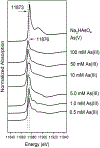Removal of Arsenate and Arsenite in Equimolar Ferrous and Ferric Sulfate Solutions through Mineral Coprecipitation: Formation of Sulfate Green Rust, Goethite, and Lepidocrocite
- PMID: 33629038
- PMCID: PMC7898115
- DOI: 10.3390/soilsystems4040068
Removal of Arsenate and Arsenite in Equimolar Ferrous and Ferric Sulfate Solutions through Mineral Coprecipitation: Formation of Sulfate Green Rust, Goethite, and Lepidocrocite
Abstract
An improved understanding of in situ mineralization in the presence of dissolved arsenic and both ferrous and ferric iron is necessary because it is an important geochemical process in the fate and transformation of arsenic and iron in groundwater systems. This work aimed at evaluating mineral phases that could form and the related transformation of arsenic species during coprecipitation. We conducted batch tests to precipitate ferrous (133 mM) and ferric (133 mM) ions in sulfate (533 mM) solutions spiked with As (0-100 mM As(V) or As(III)) and titrated with solid NaOH (400 mM). Goethite and lepidocrocite were formed at 0.5-5 mM As(V) or As(III). Only lepidocrocite formed at 10 mM As(III). Only goethite formed in the absence of added As(V) or As(III). Iron (II, III) hydroxysulfate green rust (sulfate green rust or SGR) was formed at 50 mM As(III) at an equilibrium pH of 6.34. X-ray analysis indicated that amorphous solid products were formed at 10-100 mM As(V) or 100 mM As(III). The batch tests showed that As removal ranged from 98.65-100%. Total arsenic concentrations in the formed solid phases increased with the initial solution arsenic concentrations ranging from 1.85-20.7 g kg-1. Substantial oxidation of initially added As(III) to As(V) occurred, whereas As(V) reduction did not occur. This study demonstrates that concentrations and species of arsenic in the parent solution influence the mineralogy of coprecipitated solid phases, which in turn affects As redox transformations.
Keywords: Raman spectroscopy; X-ray absorption spectroscopy; arsenic coprecipitation; iron oxides; redox transformation.
Conflict of interest statement
Conflicts of Interest: The authors declare no conflict of interests.
Figures



Similar articles
-
Partitioning and transformation behavior of arsenic during Fe(III)-As(III)-As(V)-SO42- coprecipitation and subsequent aging process in acidic solutions: Implication for arsenic mobility and fixation.Sci Total Environ. 2021 Dec 10;799:149474. doi: 10.1016/j.scitotenv.2021.149474. Epub 2021 Aug 4. Sci Total Environ. 2021. PMID: 34426338
-
Arsenic(III) and arsenic(V) speciation during transformation of lepidocrocite to magnetite.Environ Sci Technol. 2014 Dec 16;48(24):14282-90. doi: 10.1021/es5033629. Epub 2014 Dec 4. Environ Sci Technol. 2014. PMID: 25425339
-
Interaction mechanisms and kinetics of ferrous ion and hexagonal birnessite in aqueous systems.Geochem Trans. 2015 Sep 22;16(1):16. doi: 10.1186/s12932-015-0031-3. eCollection 2015 Dec. Geochem Trans. 2015. PMID: 26435697 Free PMC article.
-
Arsenate-reducing bacteria-mediated arsenic speciation changes and redistribution during mineral transformations in arsenate-associated goethite.J Hazard Mater. 2020 Nov 5;398:122886. doi: 10.1016/j.jhazmat.2020.122886. Epub 2020 May 16. J Hazard Mater. 2020. PMID: 32512445
-
Evidences on As(III) and As(V) interaction with iron(III) oxides: Hematite and goethite.J Environ Sci Health A Tox Hazard Subst Environ Eng. 2021;56(9):1007-1018. doi: 10.1080/10934529.2021.1959173. Epub 2021 Aug 13. J Environ Sci Health A Tox Hazard Subst Environ Eng. 2021. PMID: 34387542
References
-
- Smedley PL; Kinniburgh DG A review of the source, behavior and distribution of arsenic in natural waters. Appl. Geochem 2002, 17, 517–568.
-
- Stollenwerk KG; Breit GN; Welch AH; Yount JC; Whitney JW; Foster AL; Uddin MN; Majumder RK; Ahmed N Arsenic attenuation by oxidized aquifer sediments in Bangladesh. Sci. Total Environ 2007, 379, 133–150. - PubMed
-
- Smith SJ Naturally Occurring Arsenic in Ground Water, Norman, Oklahoma, 2004, and Remediation Options for Produced Water; U.S. Geological Survey Fact Sheet 2005–3111; U.S. Geological Survey: Oklahoma City, OK, USA, 2005; p. 6.
-
- Nickson R; McArthur J; Ravenscroft P; Burgess W; Ahmed K Mechanism of arsenic release to groundwater, Bangladesh and West Bengal. Appl. Geochem 2000, 15, 403–413.
-
- Wang S; Mulligan CN Effect of natural organic matter on arsenic release from soils and sediments into groundwater. Environ. Geochem. Health 2006, 28, 197–214. - PubMed
Grants and funding
LinkOut - more resources
Full Text Sources
Research Materials
